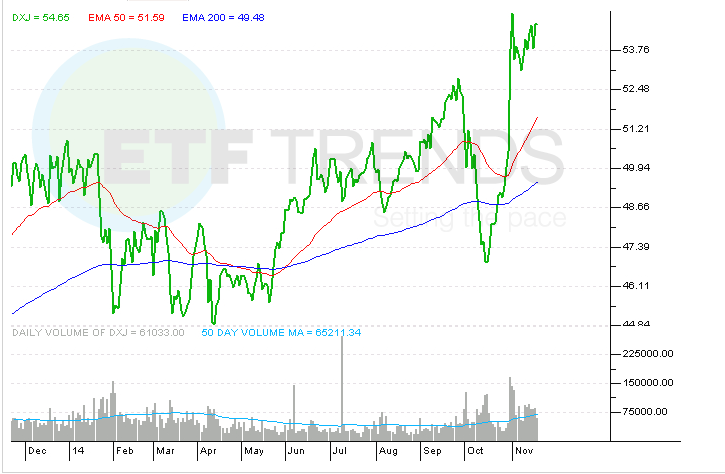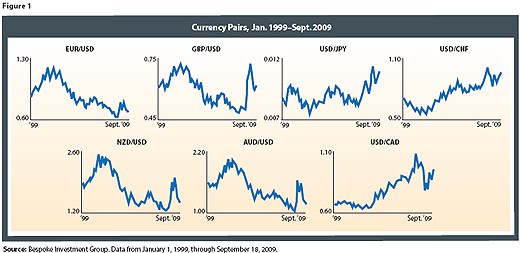Hedged ETFs Provide Foreign Exposure Sans Currency Risk
Post on: 24 Май, 2015 No Comment

By DailyAlts Staff
A new whitepaper from Deutsche Asset & Wealth Management (Deutsche AWM) considers the benefits of using currency-hedged ETFs (exchange-traded funds) to gain foreign equity exposure. Written by Deutsche AWM ETF strategists Dodd Kittsley and Abby Woddham, the paper explores the growth of investor interest in foreign stocks and the ETFs that hold them, as well as considering the potential currency risk of holding unhedged foreign equities.
Foreign Investment Difficulties
Investing in foreign stocks has been difficult historically for a variety of reasons. First and foremost, most foreign stocks trade on foreign exchanges, and domestic investors inherently have reduced access to foreign exchanges. Furthermore, stocks trading on foreign exchanges are priced in foreign currencies, creating an intermediary requirement (and hassle) for U.S. investors to first exchange dollars for foreign currencies, and also creating the phenomenon of currency risk — the risk that exchange rates between the dollar and the foreign currency will change during the holding period of the foreign stock.
Overcoming Those Difficulties
Over time, these difficulties have been addressed one by one. First, the number of foreign stocks trading on U.S. exchanges has increased steadily over time, including Alibaba’s record-breaking IPO last year. Secondly, U.S. investor access to foreign exchange markets has increased — but even more significantly, the rise of ETFs that hold stocks trading on foreign exchanges has greatly expanded investor access to such stocks. Indeed, the low cost, tax efficiency, liquidity, and transparency of ETFs has made them perhaps the most popular means of gaining foreign equity exposure. But for unhedged foreign stock ETFs, the phenomenon of currency risk remains — and it can have a devastating impact on an investment’s results.
An Example of Currency Risk
Deutsche AWM’s whitepaper offers the following example as evidence: Imagine you wanted to buy $150,000 of a stock trading on a German exchange, with the stock’s shares priced in euros. Suppose the exchange rate at the time of the purchase was $1.50 to 1 euro, and therefore $150,000 would buy 100,000 euros worth. Now imagine that a year later, the stock price is flat, and you therefore still have 100,000 euros worth of shares — but unfortunately, the dollar has strengthened against the euro so that $1 equals 1 euro. In this case, your 100,000 euros worth of stock, that you paid $150,000 for a year earlier, would now be worth just $100,000. Due to currency risk, an investment that would have resulted in a breakeven return became a 33% loss. This is illustrated below:

How Currency Hedging Works
In response, ETF providers have developed currency-hedged products. These ETFs hold shares of stocks priced in foreign currencies, but they use forward currency contracts to hedge against currency risk. This is done by agreeing to sell the foreign currency at the current exchange rate sometime in the future — if, in the example above, you would have agreed to sell 100,000 euros for $150,000 one year in the future at the same moment you bought 100,000 euros worth of stock; then a year later, your stock would still be flat at 100,000 euros, but instead of losing 33% to currency fluctuations, your forward contract would offset that loss with a 33% gain. You could sell your shares for 100,000 euros, but instead of exchanging them for $100,000 at the current exchange rate, your forward contract would entitle you to sell them for $150,000.
Conclusion
The authors of Deutsche AWM’s paper point out that currency risk is a blade that can cut both ways: Japanese stocks were up 54.6% in 2013 when priced in yen, but only 27.2% when priced in dollars due to the dollar strengthening against the yen that year. But when Japanese stocks only gained 0.6% in 2010 priced in yen, they gained 15.4% that same year priced in dollars due to the yen’s strengthening against the dollar that year.
Since exchange-rate changes can have either positive or negative impacts on an investment’s value, the whitepaper’s authors suggest strategically choosing to hedge or not hedge based on the outlook for the particular currencies involved. But with the dollar widely expected to strengthen in 2015 as the Federal Reserve begins raising interest rates, currency-hedged ETFs may be particularly worth the consideration of investors seeking exposure to foreign stocks.














